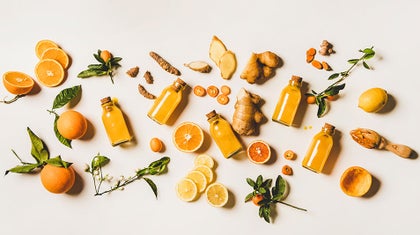5 healthy veggies you might not know about
by Sam Higham on Monday 09 September 2024
4 min read
There’s a whole world of weird and wonderful vegetables to find out about, from the unusually shaped romanesco right through to taro pretending to be a purple potato. Discover 5 lesser-known vegetables with a few hidden health secrets.
1. Kohlrabi
Kohlrabi, also known as the German turnip, is a bulbous vegetable that belongs to the cabbage family. It has a mild, slightly sweet taste, making it a versatile addition to both raw and cooked dishes.
Nutritional benefits:
Kohlrabi is high in Vitamin C, which supports immune function, and rich in dietary fibre, which promotes digestive health. It has plenty of potassium and beta carotene, nutrients that promote weight loss, boost gastrointestinal health, build immunity, and manage blood pressure.
How to prepare kohlrabi:
Enjoy it raw, shredded in salads, or sautéed in stir-fries for a crisp texture and flavour.
2. Sunchokes (Jerusalem artichokes)
Sunchokes resemble a knobbly potato but have a sweeter, nuttier flavour. They are sometimes called Jerusalem artichokes, but don’t be fooled, they’re not related to artichokes.
Nutritional benefits:
Sunchokes are high in iron, which is crucial for blood health, and potassium, which helps regulate heart function. They are also rich in inulin, a prebiotic fibre. Inulin has a lot of health benefits:
- promotes gut health
- helps regulate bowels
- balances blood sugar
- regulates blood pressure
- reduce cholesterol
- protects against cancers
How to cook sunchokes:
Sunchokes have a bold flavour, so it can be great in vegetarian recipes, roasting with a bit of olive oil, salt, and pepper, or sliced thinly in salads. Crispy pan-fried Jerusalem artichokes go well with meat and fish.
Romanesco
You’ve probably never seen a vegetable like this before. Romanesco is a unique vegetable that resembles a cauliflower but with a striking pattern. It has a slightly nutty, more delicate taste compared to its cauliflower cousin.
Nutritional benefits:
Romanesco is an excellent low-carb vegetable and a good source of vitamins and minerals, including Vitamin C, Vitamin K, Vitamin B6, potassium, folate, and manganese. These nutrients play crucial roles in boosting your immune function, aiding in blood clotting, bone health, and energy metabolism.
How to cook with romanesco:
Steam or roast romanesco to bring out its natural sweetness. Simply pan fry a slice to add the illusion of meat in vegetarian recipes. We think it’d work well with our protein-packed shakshuka breakfast recipe.
Watercress
Watercress is a leafy green known for its peppery flavour. Often found growing near water, people used to think of watercress as a weed, now it’s a super versatile, low carbohydrate food.
Nutritional benefits:
Not just a pretty flower, watercress is incredibly high in Vitamin K, with one cup (34 grams) of watercress providing over 100% of the RDI (recommended daily intake) of Vitamin K. This is necessary for blood clotting and healthy bones. It's also loaded with antioxidants that help reduce oxidative stress.
How to cook with watercress:
It can be used as a simple garnish, or simply added to salads, soups, sandwiches, and smoothies. It goes so well in one of our 5-mind blowing nourish bowl recipes.
Taro
Taro is like a potato, only purple on the inside. It’s a starchy root vegetable with a mildly sweet and nutty flavour. Taro is commonly used in both sweet and savoury dishes, and is even being turned into ice cream.
Nutritional benefits:
Taro is a great source of dietary fibre (twice as much fibre compared to a potato), which supports digestive health and relieves issue like constipation, diarrhea, stomach ulcers, and acid reflux. It can also contribute and support healthy weight loss.
Taro has high levels of Vitamin C, Vitamin B6, and Vitamin E, which help to maintain a healthy immune system. Combine this carbohydrate rich vegetable with some protein-rich plant-based foods and you’ll be unstoppable at your next Cycle class with all that fuel.
How to cook with taro:
Taro can be boiled, roasted, or mashed. It’s a versatile vegetable that can be made into soups and stews, or as a great alternative for healthy homemade ‘potato’ chips. Yum!
So now you know. Just because they’re lesser known, doesn’t mean they’re hard to get. Be sure to support your local farmers by exploring a new variety of veggies and discover the health benefits that come with them. Nurturing your body comes with taking care of your mind and soul, too. We can help here. Join us for a heart racing workout with hundreds of weekly exercise classes to choose from, or enjoy the most of your rest day with our rest and recovery spaces. Not a member? Book a club tour today.
Related articles
Nourish
4 min read
7 healthy shots you need to try
Unwind
3 min read
Are you experiencing mental or physical fatigue?
Nourish
3 min read
4 quick, nourishing breakfasts for busy professionals
Enjoying our blog?
Sign up to our newsletter to get updates on training, healthy living, news and events.








